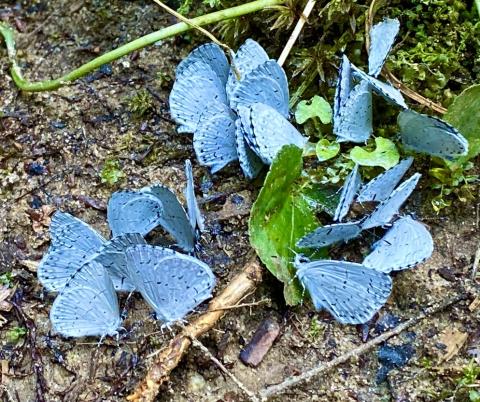The Strange Butterfly Diet

Besides flower nectar, butterflies also feed on less savory items, such as this urine deposit, which is full of salts, amino acids, and other needed nutrients.
Steve Roark
Volunteer, Cumberland Gap National Historical Park
Most people associate butterflies with flowers, watching them tranquilly sipping nectar like royalty. However, you may also see butterflies hanging around less savory food.
Flight is energy expensive, and butterflies get most of the calories needed from sugars found in flower nectar. The best flowers produce nectar with a 20-25% sugar content and store it in chambers that can be easily penetrated by the butterflies’ proboscis, a sipping straw-like mouth part. Suitable blossoms also provide a good landing pad on which to feed, the favorites being asters, daisies, milkweeds, mustards, mints, peas, and vervains.
Nectar provides high energy food, but they also seek other nutrition as well, such as salts, nitrogen, amino acids, and certain chemicals used for making sex attractants. Butterflies are very opportunistic creatures, and so their grocery list includes tree sap, wet soil, flower pollen, rotting fruit and vegetables, carrion, mammal dung, urine, bird droppings, slug slime, tears, sweat, and other animal secretions. These items do not come to mind when we think of colorful, frolicking butterflies.
Butterflies have a mating process that involves providing a “nuptial gift”. During copulation, the male transfers a spermatophore, a capsule of nutrients, salts, and sperm, to the female. This is no small gift, as a spermatophore can weigh 10 to 50% of the male butterfly’s own weight. The female depends on it for the materials necessary to provision herself and her eggs and allows her to devote more time to locating host plants on which to lay them.
To find the chemical compounds essential to the nuptial gift, male butterflies are the ones most often found clustered around urine-soaked ground or cow piles, forming what are called “puddle clubs”. These waste products are a cornucopia of nitrogen, amino acids, salts, and sugars. To an unmated male butterfly, such food sources are the best buffet ever. Decaying carcasses are even better.
Information for this article was acquired from “Butterfly Buffet”, Natural History Magazine, July 2001. This is a good magazine for nature lovers.
- Log in to post comments